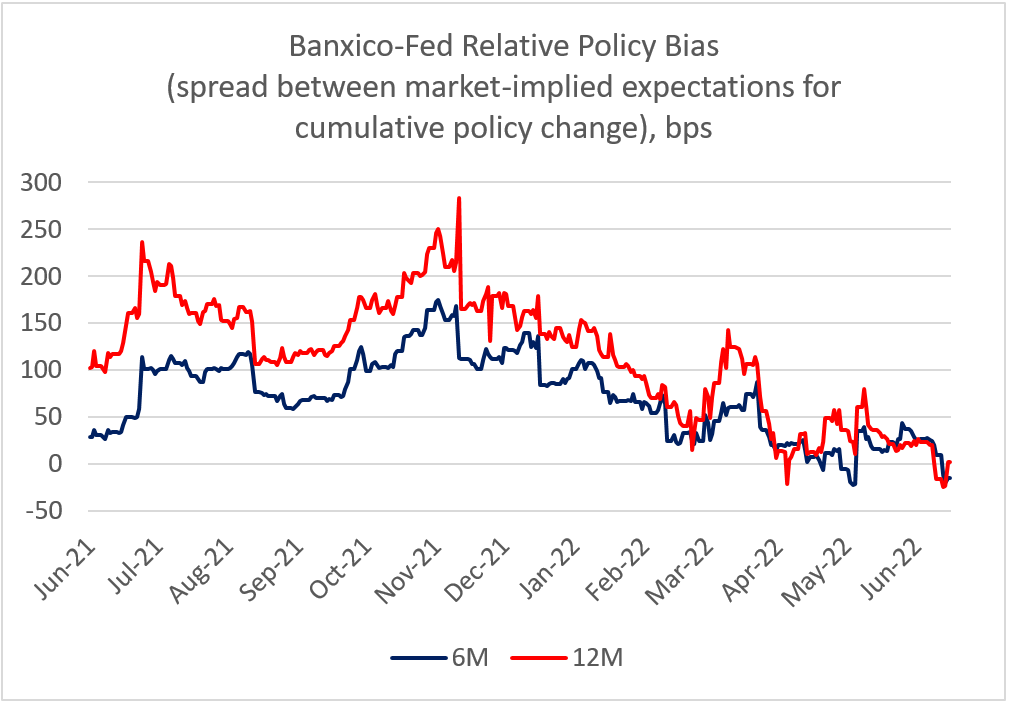By Natalia Gurushina
Chief Economist, Emerging Markets Fixed Income
Reaction to U.S. Fed Rate Hike, Guidance
The U.S. Federal Reserve (Fed) had spoken, and the market is still adjusting after yesterday’s 75bps hike and the higher terminal rate implied by the “dot plot” (=anti-inflation message). However, Chairman Jerome Powell also indicated that 75 basis-point moves might not be “common”, leading to the post-meeting rally in rates and risk assets. The market sentiment this morning was more somber, with many asset prices in the red and a lot of questions regarding the outlook for policy rates in emerging markets (EM), many of which started to hike aggressively months ago. Will the market be able to differentiate in the current environment – especially following a bunch of post-Fed rate hikes in developed markets (DM), some of which (+50bps in Switzerland) caught observers by surprise? LATAM might be a useful case-study.
Brazil Slows the Pace of Tightening
The Brazilian central bank confirmed yesterday that it is in the “exit mode”, slowing the pace of rate hikes to 50bps from 100bps in May. It still sees another hike (potentially smaller) in August, with the board keeping an eye on (a) the worsening global backdrop, and (b) fiscal developments domestically (the congress’s drive to lower inflation by cutting some taxes). Conveniently, the Brazilian market is closed today, so the reaction might be delayed/muted – the central bank’s minutes (to be released next week) is a “must read” for investors in local bonds.
Will Mexico Follow U.S. Fed?
Mexico’s rate-setting meeting takes place next week, and it will be preceded by a bi-weekly inflation print, which might help to determine how forceful the policy response will be. Other considerations can be important as well. The chart below shows what we call “relative policy bias” between Mexico’s central bank (Banxico) and the Fed – i.e., the difference between the expected amounts of tightening in the two countries. This relative policy bias is now negative – which means that the Fed is expected to deliver more hikes than the Banxico both in 6 months and 12 months. We also noticed that even though the market-implied terminal rate in Mexico (around 10%) is still expected to be much higher than in the U.S., the differential between the two rates has been narrowing in the past weeks. Can these considerations encourage the Banxico to go for a larger rate hike (+100bps), or will the higher odds of the recession in the U.S. (Mexico’s main trade partner) limit appetite for frontloading? Stay tuned!
Chart at a Glance: Mexico-U.S. Relative Policy Tightening – Changing Expectations

Source: VanEck Research; Bloomberg LP
Originally published by VanEck on June 16, 2022.
For more news, information, and strategy, visit the Beyond Basic Beta Channel.
PMI – Purchasing Managers’ Index: economic indicators derived from monthly surveys of private sector companies. A reading above 50 indicates expansion, and a reading below 50 indicates contraction; ISM – Institute for Supply Management PMI: ISM releases an index based on more than 400 purchasing and supply managers surveys; both in the manufacturing and non-manufacturing industries; CPI – Consumer Price Index: an index of the variation in prices paid by typical consumers for retail goods and other items; PPI – Producer Price Index: a family of indexes that measures the average change in selling prices received by domestic producers of goods and services over time; PCE inflation – Personal Consumption Expenditures Price Index: one measure of U.S. inflation, tracking the change in prices of goods and services purchased by consumers throughout the economy; MSCI – Morgan Stanley Capital International: an American provider of equity, fixed income, hedge fund stock market indexes, and equity portfolio analysis tools; VIX – CBOE Volatility Index: an index created by the Chicago Board Options Exchange (CBOE), which shows the market’s expectation of 30-day volatility. It is constructed using the implied volatilities on S&P 500 index options.; GBI-EM – JP Morgan’s Government Bond Index – Emerging Markets: comprehensive emerging market debt benchmarks that track local currency bonds issued by Emerging market governments; EMBI – JP Morgan’s Emerging Market Bond Index: JP Morgan’s index of dollar-denominated sovereign bonds issued by a selection of emerging market countries; EMBIG – JP Morgan’s Emerging Market Bond Index Global: tracks total returns for traded external debt instruments in emerging markets.
The information presented does not involve the rendering of personalized investment, financial, legal, or tax advice. This is not an offer to buy or sell, or a solicitation of any offer to buy or sell any of the securities mentioned herein. Certain statements contained herein may constitute projections, forecasts and other forward looking statements, which do not reflect actual results. Certain information may be provided by third-party sources and, although believed to be reliable, it has not been independently verified and its accuracy or completeness cannot be guaranteed. Any opinions, projections, forecasts, and forward-looking statements presented herein are valid as the date of this communication and are subject to change. The information herein represents the opinion of the author(s), but not necessarily those of VanEck.
Investing in international markets carries risks such as currency fluctuation, regulatory risks, economic and political instability. Emerging markets involve heightened risks related to the same factors as well as increased volatility, lower trading volume, and less liquidity. Emerging markets can have greater custodial and operational risks, and less developed legal and accounting systems than developed markets.
All investing is subject to risk, including the possible loss of the money you invest. As with any investment strategy, there is no guarantee that investment objectives will be met and investors may lose money. Diversification does not ensure a profit or protect against a loss in a declining market. Past performance is no guarantee of future performance.







